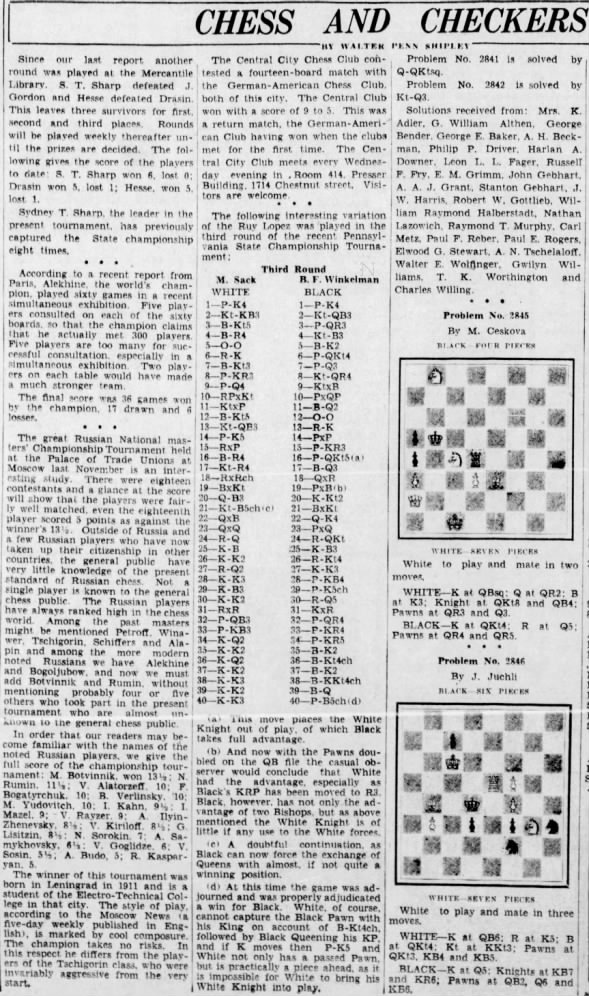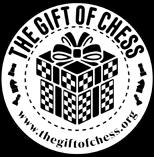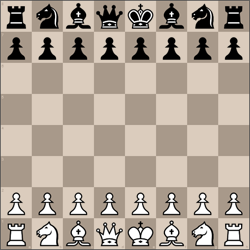< Prev
Index
Next >
 Chess and Checkers 13 Mar 1932, Sun The Philadelphia Inquirer (Philadelphia, Pennsylvania) Newspapers.com
Chess and Checkers 13 Mar 1932, Sun The Philadelphia Inquirer (Philadelphia, Pennsylvania) Newspapers.com
The great Russian National masters' Championship Tournament held at the Palace of Trade Unions at Moscow last November is an interesting study. There were eighteen contestants and a glance at the score will show that the players were fairly well matched, even the eighteenth player scored 5 points as against the winner's 13½. Outside of Russia and a few Russian players who have now taken up their citizenship in other countries, the general public have very little knowledge of the present standard of Russian chess. Not a single player is known to the general chess public. The Russian players have always ranked high in the chess world. Among the past masters might be mentioned Petroff, Winawer, Tschigorin, Schiffers and Alapin and among the more modern noted Russians we have Alekhine and Bogoljubow, and now we must add Botvinnik and Rumin, without mentioning probably four or five others who took part in the present tournament who are almost unknown to the general chess public.
In order that our readers may become familiar with the names of the noted Russian players, we give the full score of the championship tournament:
M. Botvinnik, won 13½;
N. Rumin, 11½;
V. Alatorzeff, 10;
F. Bogatyrchuk, 10;
B. Verlinsky, 10;
M. Yudovitch, 10;
I. Kahn, 9½;
I. Mazel, 9;
V. Rayzer, 9;
A. Ilyin-Zhenevsky, 8½;
V. Kiriloff, 8½;
G. Lisitzin, 8½;
N. Sorokin, 7;
A. Samykhovsky, 6½
V. Goglidze, 6;
V. Sosin, 5½;
A. Budo, 5;
R. Kasparyan, 5.
The winner of this tournament was born in Leningrad in 1911 and is a student of the Electro-Technical College in that city. The style of play, according to the Moscow News (a five-day weekly published in English), is marked by cool composure. The champion takes no risks. In this respect he differs from the players of the Tschigorin class, who were invariably aggressive from the very start.
OCR Text
Since our last report another The Central City Chess Club coh-rnund was plaved at the Mercantile ' tested a fourteen-board match with Library. S. T. Sharp defeated J. j the German-American Chess Club.
Gordon and Hesse defeated Drasln. This leaves three survivors for first, second and third places. Rounds will be played weekly thereafter until the prlr.es are decided. The fol- lowing give the score of the players! to date: S. T. Sharp won 6, lost 0; Drastn won 5, last 1; Hesse, won 5. lost, 1. Sydney T. Sharp, the leader In the present tournament, has previously raptured the State championship eight times. Pans, Alekhine.
the world's chnm pion. played sixty games in a recent simultaneous exhibition. Five plav-ers consulted on each of the sixty uumus. jo inai rne cnnmpion claims rnat ne actually met 300 Dlavers Five players are too manv for successful consultation, especially in a simultaneous exhibition. Two Plav ers on each table would have made a muen stronger team.
The final score wax 36 tames won bv the champion, 17 drawn and 6 losses, The great Russian National masters' Championship Tournament hpld at, the Palace of Trade Unions at. Moscow last. November is an interesting study. There were eighteen winner s 13.'.,. OuUside of Russia and a few Russian players who have now taken up their citiwnship in other countries, the ireneral rnhll hiv very little knowledge of the present I .-innnarn oi Kussian chess.
Not, a single player is known to the general chess public. The Russian players have always ranked high In the chess world. Among the past masters might, be mentioned PetrofT. Wtna-wer, Tschlgorin. Schiffers and Ala-pin and among the more modern noted Russians we have Alekhine add Botvinnik and Rumin.
without mentioning probably four or five others who took part in the present tournament who are almost, nn-kjiuwn u me general chess public. In order that our readers mav be come familiar with the names of the noted Russian players, we give the full score of the championship tournament: M. Botvinnik. won 13 W; N. Rumin. U1,; V. Alatorxeff. 10; F. Bogatyrehuk. 10; B. Verlinskv. '10; M. Yudovitch. 10: I. Kahn, 9s: I. Mazel. 9; -V. Rayser. 9: A. Ilvln-Zhenevsky. 8: V. KirilofT. 8'; G. Lisitzin. 8': N. Sorokin. 7: A. Sa-mykhovsky. 6W: V. Goglidre. : V. Sosin. SS: A. Budo. 5: R. KasDar- yan. 5. The winner of this tournament was born in Intngrd In 1911 and Is a student of the Electro-Technical Col lege in that city. The Mvle of plav, according to the Moscow News i"a five-day weekly published In English), is marked bv cool composure. The champion takes no risks.
In this respect he differs from the plav-ers of the Tschlgorin class, who were Invariably aggressive from the verv start. CHESS AND tlV WAI.TRK both of this city. The Central Club won with a score of 9 to 5. This was a return match, the German-American Club having won when the clubs met. for the first time.
The Cen- tral City Club meets every Wrdnes dav evening In .Room 414. Presser Building. 1714 Chestnut street, Visitors are welcome. The following interesting variation of the Ruy Lopez was played in the third round of the recent Pennsylvania State Championship Tournament: Third Round M. Sack R. F. Winkelman WHITE BLACK 1 P-K4 1 P-K4 2 KC-KB3 2 Kt-QB3 3 B-Kt5 3 P-QR3 4 B-R4 4 Kt-B3 5 O-O 5 B-K2 ' 6 R-K 6 P-QKt4 7 B-Kt3 7 P-Q3 ; 8 P-KR3 8 Kt-OR4 I 9 P-Q4 9 KtxB 10 RPxKt 10 PxOP ill KtvP 11 B-02 12 B-Kt5 12 O-O 13 Kt-QE3 13 R-K 14 P-K5 14 PxP 15 RxP 15 P-KR3 i 16 B-R4 16 P-QKtSia' j 17 Kt-R4 17 B-Q3 18 HxHch 18 QxR I 19 BxKt 19 PxB'bi j 20 Q-B3 20 K-Kt2 21 Kt-B5ch'd 21 BxKt ! 22 QxB 22 Q-K4 23 QxQ 33 PxQ 24 R-Q 24 R-QKt 25 K-B 35 K-B3 26 K-K2 26 R-Kt4 i 27 R-Q2 27 K-K3 i 28 K-K3 28 P-KB4 i 29 K-B3 2P P-K5ch 30 K-K2 30 R-05 I 31 RxR 31 KxR 32 P-OB3 32 P-QR4 j 33 P-KB3 33 P-KR4 j 34 K-Q2 34 P-KR5 j 3.V K-K2 35 B-K2 j 36 K-Q2 36 B-Kt4ch I 37 K-K2 37 B-K2 i 38 K-K3 38 B-KKt4ch 39 K-K2 39 B-Q 40 K-K3 40 P-B5ch(d) 27 R-Q2 i ins move piaces the White Knight out of play, of which Black takes full advantage. b And now with the Pawns doubled on the QB file the casual observer would conclude that White had the advantage, especially as Black's KRP has been moved to RJ. Black, however, has not only the advantage of two Bishops, but as above mentioned the White Knight, is of little if any use to the White forces. ' A doubtful continuation, as Black ran now force the exchange of Queens with almost, if not quite a winning position.
idi At this time the game was adjourned and was properly adjudicated a win for Black. White, of course, cannot capture the Black Pawn with his King on account of B-Kt4ch, followed by Black Queening his KP, and If K moves then P-K5 and White not only has a paved Pawn. out. is practically piece ahead, as it ; is impossible for White to bring his 1 Whit Knight into play.
 Chess and Checkers 13 Mar 1932, Sun The Philadelphia Inquirer (Philadelphia, Pennsylvania) Newspapers.com
Chess and Checkers 13 Mar 1932, Sun The Philadelphia Inquirer (Philadelphia, Pennsylvania) Newspapers.com



























